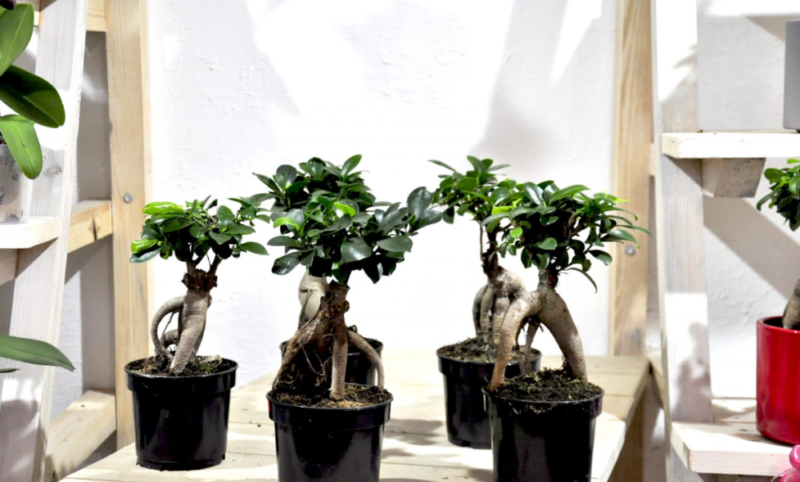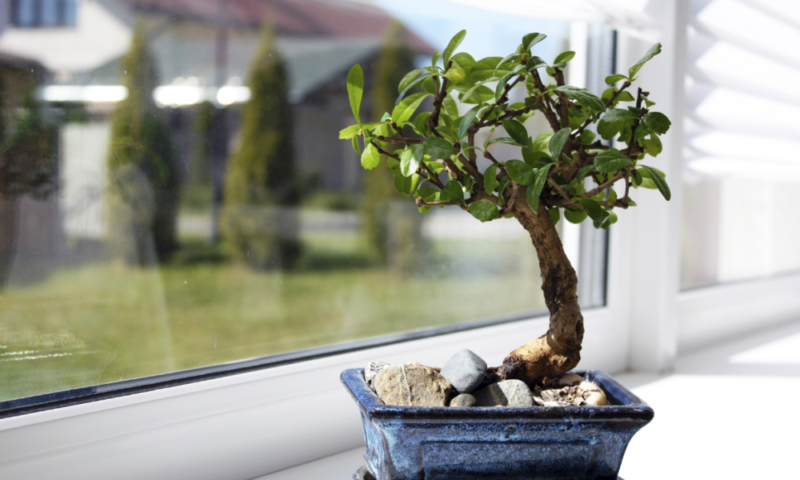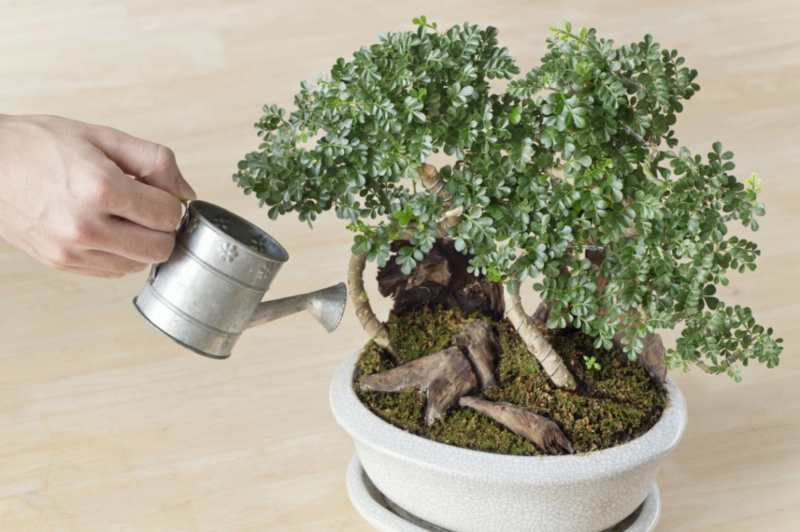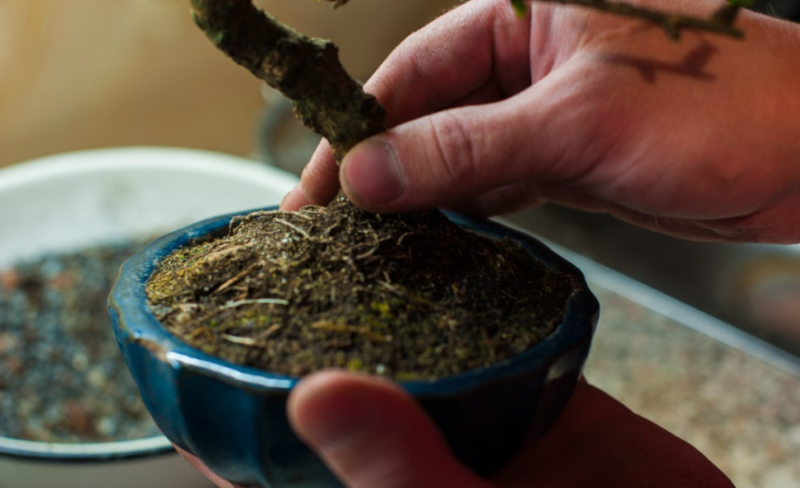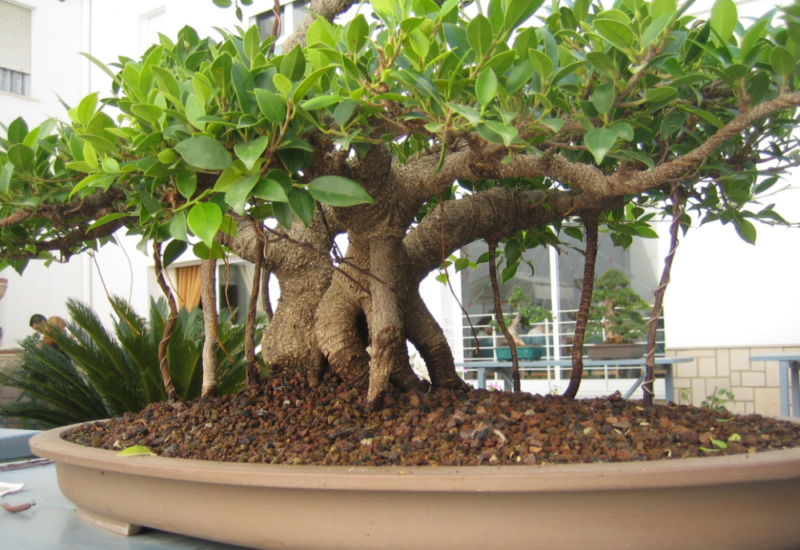You can grow ficus bonsai on your own or buy this work of art in a flower shop. The plant will become a symbol of prosperity and prosperity in the house, and care for it will require patience and care.
Material Content:
Description of ficus bonsai and the nuances of growing
Growing a decorative tree of a bizarre shape is a work that will require patience and artistic taste. A distinctive feature of a bonsai is a thick trunk, resembling century-old trees in miniature, and branches curved in a special way. The whole composition should look organic and stylish.
To make ficus bonsai, you need a sapling with a thick trunk and strong branches. The roots are cut first, and then the branches. Work is performed in the spring, ficus will better tolerate stress after trimming and will quickly recover. The plant is removed from the pot, the roots are freed from the substrate. It is advisable not to water the soil before this for 2 days, so that it crumbles more easily. Cut a thick core root with a secateurs or sharp scissors to the point where the fibrous lateral roots begin to grow.
Planted in a shallow "training" pot, where the ficus will grow for at least another year. A layer of expanded clay is poured at the bottom so that there is good drainage. Soil is used ordinary, for ficuses or decorative and deciduous plants.
About a month later, when the plant begins to give new shoots, they begin to form a crown, pruning is carried out from the bottom up, the places where shoots are removed are treated with the special Rannet tool, which promotes early healing. Transplantation and the formation of ficus continue to be done annually until it takes the desired shape.In the future, they use a special landing container-bowl for bonsai and a mixture consisting of acadama, sand, clay and humus.
To form the bends of the trunk and branches, they are wrapped with a strong, flexible wire, left in this condition for a year, until the next pruning.
Ficus Benjamin and other species have branches that easily grow together, this is used to create a thickened trunk. Several seedlings are planted in one pot, wrapped with a strong tourniquet for several months.
Suitable types for home maintenance
The plant selected for the formation must be healthy, have growth of young leaves, and be consistent in shape with the intended image. It’s better to start making bonsai from young specimens.
Such types of ficus are suitable:
- dwarf;
- Benjamin;
- microcarp;
- dark leafed.
Forming a bonsai on your own at home is a long and painstaking job. It is much easier to buy a finished plant in a garden center or flower shop. You need to choose a copy without yellow leaves, with a strong, healthy trunk. For the purchased tree, it is necessary to provide special conditions. In the nursery, where it grew before that, there was increased humidity, good lighting and regular feeding. In order for the plant to develop further and not die in two weeks, it needs to be taken care of.
Ideal conditions for plants of the Mulberry family
Most ficuses from the Mulberry family grow in the warm, humid climate of the tropics and subtropics. For the successful survival of indoor specimens will require diffused lighting, warm temperature and high humidity, regular feeding. With a lack of light, the ficus begins to drop foliage, but the bright midday sun is contraindicated. It is best to place windows facing east or northwest.
The plant does not like excess moisture in the soil; therefore, light, well-permeable moisture and air are poured into the pot. For bonsai use a moisture-intensive soil mixture. The drainage of excess moisture is facilitated by large drainage holes on the bottom of the pot, covered with a net. During irrigation, bonsai must be monitored so that the water completely saturates the substrate and escapes through the drainage holes; liquid must not be left in the pan.
The number of irrigations depends on the temperature and humidity. If the room is 16–18 ° C, it is enough to moisten the soil once a week. In summer, when it is hot and dry, you may need 2 waterings per day - morning and evening. If it is possible to place ficus bonsai from May to August in the fresh air, in the garden or on the open veranda, this will only benefit him.
Home Care
Bonsai differs from ordinary ficus in greater vulnerability. It grows in a small container with special soil, which dries quickly. Water the plant every day, using only clean, filtered water.
If the room is warm and dry, use a spray gun to moisten the foliage in the morning or evening every day. For spraying, it is advisable to use water at room temperature or 2 degrees warmer.
Top dressing begins to be applied one month after transplantation. In spring and summer, they are needed every week, and in autumn and winter - 1 time per month.
It’s best to buy specialized products such as Planet of Flowers or Pokon for Bonsai. You can use the usual complex fertilizer for ornamental foliage plants diluted with water three times more than indicated in the instructions.
And another important condition for the cultivation of ficus bonsai is its cropping and the formation or maintenance of an already created form.
Do I need a transplant after purchase
2-7 days after the purchase, the bonsai needs to be transplanted. To extract the plant, use a sharp tool to pry up an earthen lump in the bowl. Gently clean the soil from the roots with a stick, with movements from the trunk. If there are spoiled, black roots, they are cut out.
Take a low and wide bowl, corresponding in size to the root system.At the bottom there should be a drainage hole covered with a net. A dry mixture of pumice, zeolite and bonsai soil is poured into the bowl. Place the plant in a bowl, pour soil on top so that it fills the entire space between the roots. After planting, watering is carried out, dry branches are cut, if any. Wounds are coated with a special composition.
After transplantation, the bonsai is sprayed daily with warm water and watered well. The first time you water the water should come out of the holes. In the summer, it is advisable to take the plant outside, putting it in a shaded place. If the ficus transplant is carried out in winter or autumn, after watering and spraying it is advisable to put on a transplanted plant a transparent plastic bag. Then put in a warm place in a diffused, dim light. The package must be removed daily for 10-15 minutes. About a week later, when a new increase becomes noticeable, the package is gradually removed.
The plant should take root in the new conditions, give growth, and only then it can continue to form further, giving the desired shape.
Pest and Disease Control
Ficus microcarp, Benjamin and other species most often suffer from scale insects. This small insect adheres tightly to the branches and is difficult to notice immediately. The pest resembles small dark growths on the cortex. When sticky vegetable juice begins to stand out abundantly on the leaves - this is the first sign of infection with scabies.
Dry indoor air contributes to the reproduction of spider mites. The habitat of this pest will be drooping leaves and a light spider web in the crown. A closer look reveals small red-brown dots moving along the trunk.
The appearance of white lumps in petioles of leaves, on the fork of shoots and in the root zone indicates infection with a mealybug. Having noticed pests, you need to help the plant get rid of them.
You can not use insecticides that contain malathion, ficus does not tolerate them. The insect acaricide Fitoverm or neem oil can help in the fight against pests.
Most often, indoor ficuses are sick with such fungal diseases:
- Anthracnose - manifests itself in the form of rusty spots along the edges of leaves;
- cercosporosis - small dark dots appear on the underside of leaf plates, leaves turn yellow and fall off;
- root rot - a pathogenic fungus affects the roots, an unpleasant, musty smell appears from the soil in the pot, all leaves fall, the plant dies;
- sooty fungus - insect pests can serve as a carrier; dark plaque appears on the leaves.
Improper care contributes to the development of diseases - excessive watering, shading, placement of healthy and diseased plants nearby, and use of a non-sterile instrument for trimming. To treat fungal infections, fungicides are used: Trichodermin, Gamair, Tsineb, Alirin, etc. The drugs are diluted according to the instructions, if necessary, re-treatment after a certain period of time.
What problems can the flower grower face?
Sometimes a bonsai drops its leaves for no apparent reason. Pay attention to lighting, temperature and humidity in the room. It is advisable to transplant the diseased plant into a fresh substrate, checking the health of the roots. If there is rotting of the root system, it is necessary to treat with fungicides and remove damaged plant tissues using pruning.
Exposure to too bright sun or cold drafts can adversely affect. Sometimes ficus painfully reacts not only to a rearrangement in a new place, but also to plants that stand next to it.
Lack of nutrients in the soil, insect damage by pests or fungal diseases leads to leaf discharge.
The plant must be carefully examined so as not to miss the onset of the disease.
Beautiful bonsai will become a worthy decoration of the interior, the pride of the owner, many years of joint creation of nature and man.



